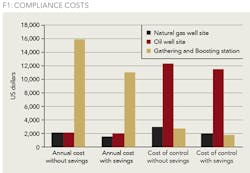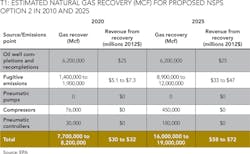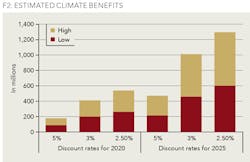What net economic benefits?
EPA'S PROPOSED METHANE REGULATIONS RELY ON NUMEROUS ASSUMPTIONS
LARRY NETTLES, VINSON & ELKINS, HOUSTON
CORINNE SNOW, VINSON & ELKINS, NEW YORK
ON SEPT. 18, 2015, the US Environmental Protection Agency published a new proposed rule to regulate methane gas emission from the oil and gas sector. The new rule would expand EPA's current volatile organic compound (VOC) emission regulations to cover additional oil and gas operations, and to create new methane standards for that expanded list of operations.
Under the proposal, the current VOC best system of emission reduction (BSER) standards found in Subpart OOOO of the Clean Air Act (CAA) regulations would apply to both methane and VOC emissions from those sources. As a result of this proposal, owners and operators will have to install new controls equipment, conduct fugitive emissions tests, and replace leaking equipment at certain hydraulically fractured oil and gas well sites, natural gas plants, and compressor stations.
Complying with these rules will not be cheap; EPA has concluded that the rule would cost the industry between $170 to $180 million in 2020 and $280 to $330 million in 2025. 1Despite these high costs, EPA concluded that its new proposed rule would have a net economic benefit of between $35 to $42 million in 2020 and $120 to $150 million in 2025. EPA reached this result by placing a value on both the methane that it believes owners and operators will be able to recover and sell as a result of the rule, and by putting a price on the value on the climate benefits of reducing methane emissions. This type of analysis can help create the public perception that a regulation is economically beneficial, even when it will take a serious toll on a particular industry.
WHY THE COST ANALYSIS?
Section 111 of the CAA requires that EPA consider a number of factors, including cost, in determining "the best system of emission reduction ... adequately demonstrated" or "BSER" standards for air emission controls. The CAA does not, however, specify how EPA should assess those costs. To determine whether the cost of a particular control is reasonable, EPA considers the capital and operating costs associated with the control, as well as the emission reductions that the control can achieve. In the context of air pollution control options, EPA's "cost effectiveness analysis" typically refers to the annualized cost of implementing an air pollution control divided by the amount of pollutant reductions realized annually. EPA has explained that its cost effectiveness analysis is not intended to be a cost-benefits analysis, but rather to provide a metric of the relative cost to reduction ratios of various control options.
Historically, courts have upheld EPA's decisions about what controls to require unless the costs are exorbitant, excessive, or "greater than the industry could bear and survive." Indeed, in the preamble to the proposed rule, EPA references the fact that courts have already upheld some of its very costly past regulations. According to EPA, this new methane proposal is well within the bounds of what the courts have found acceptable. As a result, EPA had little to prove, as a legal matter, to justify the cost of its rule. Yet EPA went out of its way to collect information and conduct a complex economic analysis that ultimately concluded that this proposed rule has a net economic benefit. The way in which EPA reached this conclusion provides insight into how economic models can be used to alter the public perception of a regulation's value.
EPA'S COST CALCULATION
EPA estimated the total industry-wide capital cost of complying with the proposed methane rule will be $170 to $180 million in 2020 and $280 to $330 million in 2025. In addition, EPA estimated the total annualized engineering costs of the proposed methane rule to be $180 to $200 million in 2020 and $370 to $500 million in 2025. The brunt of these costs will result from new compliance costs for oil well completions and recompletions-estimated to cost $120 million in compliance nationwide in both 2020 and 2025-and fugitive emissions compliance costs, which are estimated to cost $180 to $290 million in 2025.
EPA then assigned the costs of those controls to the reduction in air emissions that it expects will result from the rule. EPA acknowledges that this sort of cost estimate becomes increasingly complicated when applied to a regulation like the proposed methane rule, which will reduce the emissions of multiple different pollutants. While the total costs of compliance remain the same no matter how the costs are allocated between the two pollutants, EPA's allocation can matter in the public perception of whether the costs associated with a regulation are reasonable. For example, when EPA assigned all of the costs of compliance to reductions in methane, as opposed to allocating some of those costs to the VOC reductions, EPA determined that it would cost an average of $980 in 2020 and $1,100 per short ton of methane emissions. Alternatively, when EPA allocated some costs to VOC emissions, it determined that the cost of control for methane was much lower: $490 per ton of methane in 2020, and $530 per ton in 2025.
EPA also calculated what it considered to be the cost savings associated with the proposed rule, which allowed it to then reduce the overall costs of compliance with the proposal. To reach its cost-savings calculation, EPA took into account the revenues that it expects will be generated from selling the methane that these owners and operators will capture under the new procedure, and that would have otherwise been emitted into the atmosphere. For example, for certain wells the proposed rule would require owners and operators to route methane gas during the flowback period to a separator, and then route all salable quality gas from a separator to a flow line or collection system, re-inject the gas into the well or another well, use the gas as an on-site fuel source, or use the gas for another useful purpose. In the absence of this rule, operators might otherwise release this methane into the air.
The cost-saving analysis also considers the methane that would otherwise have been lost as "fugitive emissions" from equipment leaks at both well sites and compressor stations, as well as from rod packing replacements in reciprocating compressors, and low-bleed pneumatic devices. EPA's estimates for the additional natural gas recovery that will result from this proposal are summarized in Table 1.
EPA valued the methane at about $4.00 per Mcf, and then used this figure to reduce the costs that industry will incur. The chart below illustrates how EPA's use of this savings estimate impacted its cost projections for particular sites to comply with the proposed fugitive emissions requirements through the use of OGI technology. In each case, EPA was able to reduce the cost estimate by assuming that the methane would be sold for $4.00 per Mcf.
In total, EPA reduced the national capital costs associated with the rule by $10 million to $20 million for 2020, and reduced the costs associated with methane reductions from those controls from $738 per ton to $506 per ton. To reach these figures, EPA assumed natural gas and crude oil production levels would remain unchanged in 2020 and slightly decline in 2025. Given the current state of the oil and gas market, these assumptions may not turn out to be accurate. In fact, EPA acknowledged in its regulatory impact statement for the proposal that natural gas prices can increase or decrease rapidly, and that there is geographic variability in wellhead prices for the gas. EPA noted that these factors can also influence engineering costs: a $1/Mcf change in the wellhead price causes a change in estimated engineering compliance costs of about $8 million in 2020 and $16 to $19 million in 2025, in 2012 dollars.
EPA'S CALCULATION OF BENEFITS
Despite these high industry-wide costs, EPA concluded that the proposed rule has a net economic benefit of between $35 million to $42 million in 2020 and $120 million to $150 million in 2025. This conclusion is based in part on valuing the reductions in methane emissions through a measurement which uses modeling of projected future climate impacts to place a current dollar-figure value on emissions reductions. EPA explained in the proposed rule that it is regulating methane emissions because they are considered a potent greenhouse gas (GHG), and not because they present the kinds of health harms associated with traditional air pollutants. As a result, the benefits of emission reductions must be tied to climate change impacts. For context, EPA estimated that the US oil and gas sector accounts for just over two percent of the total US GHG emissions, and 0.3% of global GHG emissions.
Over the past two decades, economists have been developing a tool known as the social cost of carbon (SCC) in an attempt to quantify the global costs associated with incremental changes in GHG emissions on a macro-level. In theory, an SCC model could capture all of the changes, both positive and negative, that each additional unit of GHGs would have on various regions of the globe and result in a single monetary value for the impact of a unit of emissions. Since 2008 federal agencies have been using the SCC as part of their cost-benefit analyses. Originally, these agencies relied on differing models and estimates to assess the SCC, with estimates ranged anywhere from approximately $0-150/ton CO2.
In 2010, an Interagency Work Group (IWG) released a report which created a uniform SCC value for federal agencies to use in assessing the impacts of their actions. The IWG recently revised its SCC figures, so that reductions in GHGs are valued at $36/ton of CO2 for 2015 at a three percent discount rate. The IWG has not estimated the social costs associated with GHGs other than CO2. As a result, EPA's calculation for the proposed methane rule was based on a variation of that calculation called the social cost of methane (SC-CH4).
The proposed rule includes a chart of various values per ton of methane, but for the sake of the cost-benefit analysis, EPA is using a 3% discount rate, which values the methane at $1,100/ton in 2015. EPA has previously concluded that the comparative impact of a pound of methane on climate change is 25-times greater than a pound of carbon dioxide over a 100-year period. This comparative potency is one reason why the model used by EPA results in a much higher value for each ton of methane reductions that would result from its proposed rule as compared to the value of CO2 under the SCC. EPA anticipated that the proposed rule would prevent 170,000 to 180,000 short tons of new methane emissions in 2020. The proposal estimates that these emission reductions would increase to 340,000 to 400,000 short tons of methane in 2025. As a result, EPA estimates the methane-related monetized climate benefits of the proposal to be $200 million to $210 million in 2020 and $460 million to $550 million in 2025.
Critics of these models argue that it is very hard to accurately determine future impacts that will occur hundreds of years in the future. Indeed, EPA acknowledged some of these shortcomings in its proposed rule, but concluded that these estimates represent the best available information about the social benefits of GHG reductions. The National Academies of Sciences, Engineering, and Medicine have recently begun a review of IWG's SCC calculation and are expected to release interim results in 2016. As part of the review, they are also receiving comments and input from the public on the model.
Critics have also noted that the figures resulting from these models vary drastically depending on the discount rate used to determine the present value of those costs. For example, at the 7% discount rate used by EPA to assess the costs of complying with this rule, many SCC models would determine that the value of a ton of CO2 to be zero, or even slightly negative. The chart of SC-CH4 rates used by EPA shows that the value of a ton of methane emissions drops from $1,100 to $490 for 2015 when the discount rate is changed from 3% to 5%. While the chart does not include the figures at a 7% rate, they would presumably be even lower. And as Table 2 demonstrates, the disparity between the values at different discount rates only increases in the future.
As a result, EPA's benefit estimate is highly sensitive to the discount rate applied, as illustrated in Figure 2.
Even if these models can accurately reflect the economic value of future climate impacts, some may also question whether it appropriate for EPA to compare those global benefits that will occur far out into the future at a 3% discount rate to domestic compliance costs that will occur over the next 10 years, which are determined at a 7% discount rate.
Conclusion
EPA's cost assessment concludes that there is a net economic benefit to the newly proposed methane regulations for the oil and gas sector despite the high costs of compliance. A closer look at EPA's calculations, however, shows that this conclusion relies on a number of assumptions about the value of the methane that owners and operators will recover, and the social value of the reductions in methane emissions.
ABOUT THE AUTHORS
Larry Nettles is a partner in Vinson & Elkins' Houston office. He has been practicing environmental law full-time since 1981. He has a broad range of experience in counseling, permitting, and civil and criminal litigation, and has a proven track record in negotiating settlements and liability allocation agreements to resolve complex environmental problems. Nettles currently serves as Co-Chair of Vinson & Elkins' Energy and Infrastructure practice group and Chair of the Shale and Hydraulic Fracturing Task Force. He is also a member of V&E's Environmental and Natural Resources and Climate Change practice groups.
Corinne Snow is an associate in Vinson & Elkins' New York office. Her principal area of practice is environmental law, with an emphasis on regulatory compliance, environmental litigation, and enforcement defense. Snow's other practice areas include general litigation, permitting and transactional environmental issues, and emergency response to onshore and offshore accidents.
This article is intended for educational and informational purposes only and does not constitute legal advice or services. These materials represent the views of and summaries by the authors. They do not necessarily reflect the opinions or views of Vinson & Elkins LLP or of any of its other attorneys or clients.
1All of EPA's estimates throughout this article are in 2012 dollars.







